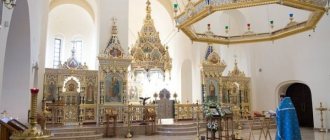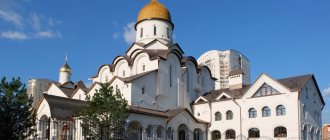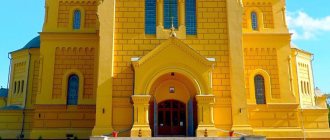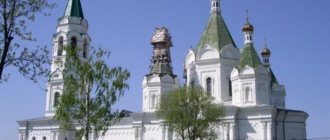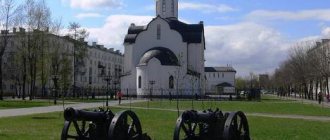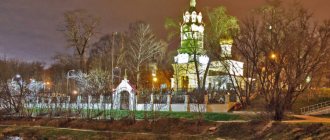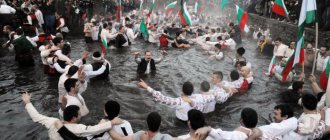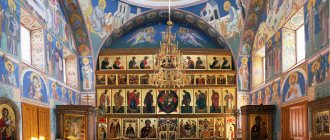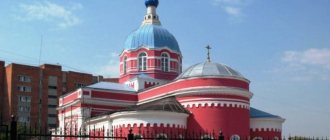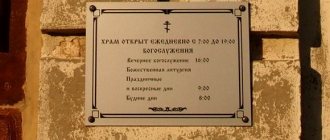| Novosibirsk Alexander Nevsky Cathedral |
Novosibirsk Cathedral in the name of the Blessed Grand Duke Alexander Nevsky
of the Novosibirsk diocese
- Thrones: blgv. led book Alexander Nevsky (main), St. Nicholas the Wonderworker (altar), martyr. St. George the Victorious (altar)
- Address: Russia, 630007, Novosibirsk, Krasny prosp., 1a
- Tel., 223-54-40
- Official site:
- On the map: Yandex.Map, Google map
The majestic temple is located on an elevated site near the railway bridge across the Ob, at the beginning of the city’s main thoroughfare.
| Novonikolaevsky Alexander Nevsky Cathedral. Photo beginning XX century |
Construction
On October 10, 1895, the residents of the village decided to ask the Bishop of Tomsk, Saint Macarius (Nevsky), for his blessing to build a church in the name of the blessed Prince Alexander Nevsky. A committee was formed headed by the head of the construction of the Central Siberian section of the railway, engineer N. G. Mezheninov. The committee organized a collection of donations for the construction of the temple, chose a site for it on an elevated area near the railway bridge, at the beginning of a forest clearing - the main thoroughfare of the future city.
Temporarily, before the construction of the stone temple, it was allowed to build a wooden prayer house. Within a month, it was built with funds from residents and opened on November 24, 1895. Separately, next to the church, there was a bell tower on wooden pillars. In December of that year, the prayer house was consecrated by priest Konstantin Lvov. Vasily Poselsky became the first priest in the village. After the construction of the brick church was completed, the prayer house was dismantled and moved to a new site along Budagovskaya Street (now Bolshevikskaya).
In the village, by decree of the Holy Synod of February 10, 1896 No. 780, an independent parish was opened with a clergy of a priest and a psalm-reader. By subsequent decree No. 2877 of March 18, 1898, the church staff was increased by one more priest, deacon and psalm-reader.
The royal family paid considerable attention to the construction, because the temple was erected in memory of the organizer of the Great Siberian Route, Emperor Alexander III. In April 1896, the Passion-Bearer Emperor Nicholas II granted a plot of land equal to one tithe of land belonging to His Majesty's Cabinet for the construction of the temple and clergy houses. He donated 5,000 rubles for the construction of the temple and 6,500 rubles for the production of the iconostasis. On December 7, 1899, the sovereign also donated priestly and deacon vestments, made of gold brocade, which served as a cover for the coffin of Grand Duke Georgy Alexandrovich. He also donated icons of the Athonite script to the temple: a copy of the Iveron image of the Mother of God and an icon of the Great Martyr Panteleimon the Healer. The image of the Great Martyr George the Victorious was granted by Empress Maria Feodorovna.
On May 15, 1897, a solemn prayer service was held to mark the foundation of the temple. The construction project was headed by order of the Ministry of Railways by travel engineer N.M. Tikhomirov. The cathedral was built according to the design of the architect K.K. Lygin [1], the model for which was the Church of the Merciful Icon of the Mother of God in St. Petersburg.
By the end of 1898, the laying of the brick walls of the church was completed. The painting of the church was carried out by the Tomsk icon painting workshop of I. A. Pankryshev. A tyablo iconostasis was installed in the church, and Dutch tiles were laid on the floor. The clergy register indicates that the church had sufficient furnishings. Three wooden houses were built to house the clergy staff.
On December 29, 1899, the main altar of the church was consecrated by Bishop Macarius. On December 1 and 29, 1904, with his blessing, the side chapels of the temple were consecrated. The temple became the largest and most beautiful of all the churches built with funds from the Alexander III Foundation. The Alexander Nevsky Church, which was the first stone church of the city, rose with its domes above the two-story merchant houses and stone shopping arcades running up the wide Nikolaevsky Avenue.
For many years, the Alexander Nevsky Church became the center of the city’s spiritual life. In February 1910, the temple became the center of the Novonikolaevsky deanery. In the parish of the temple there were two ascribed churches: the Resurrection of the Lord and the Intercession of the Blessed Virgin Mary, which in 1913 were separated into independent parishes. In 1915, the temple received the status of a cathedral.
In the first post-revolutionary years, parish activities continued. So, on June 25, 1918, at a general meeting of parishioners chaired by the rector, Archpriest Nikolai Nikolsky, the issue of opening a Sisterhood at the church to help the elderly and sick was discussed.
Desecration
From 1923 to 1938, the cathedral was occupied by renovationists; it housed the department of their Siberian Metropolitan. In 1938, by order of the regional executive committee, the temple was closed.
The bells and crosses were removed and the bell tower was demolished. In the 1930s, attempts were made to blow up the cathedral, but the charges only destroyed the partitions. They did not dare to increase the power of the charges, since next door there was the building of the Zapsibkrai Executive Committee, which could have collapsed.
In the 1940s Employees of the Promstroyproekt design institute were stationed in the cathedral. During these years, a ceiling and a flight of stairs were built into the interior of the temple, window frames were replaced, the masonry of the facades was partially damaged, and the painting was completely destroyed. In 1957, by decision of the City Executive Committee, the building was transferred to the West Siberian Newsreel Studio, which remained there until the spring of 1984. During the studio's operation, the cathedral premises were repeatedly redeveloped: additional ceilings were installed on huge channels, rooms were built on the floors, fire exits were made from the windows of the second tier. They made a room out of the dome. The choir staircase led to the hall for viewing film materials. The administration and film archives are located on the ground floor.
By decision of the regional executive committee No. 236 of April 14, 1976, the cathedral was recognized as an architectural monument of regional significance. In its technical passport there was an entry: “The cathedral has no significance as a monument of religious architecture. It is valuable primarily because it is the first stone building in the city.”
In 1984, the building went to the Novosibirsk Philharmonic. At that time, a restoration and reconstruction project was developed with the idea of building a chamber concert hall inside, which implied the construction of another underground tier. In 1988, they already wanted to begin implementing their plan, but city residents intervened, advocating for the return of the cathedral to the Russian Orthodox Church.
| Novosibirsk Alexander Nevsky Cathedral. Restoration work beginning 1990s. |
Recovery
The movement for the return of the cathedral to the Church unfolded in Novosibirsk in connection with the celebration of the 1000th anniversary of the Baptism of Rus'. In 1988, an initiative group of 20 people was created to return the cathedral to the Church. In December of that year, at the scientific and public conference “Christianity in the history and culture of Russia,” it was decided to achieve the transfer of the temple to the jurisdiction of the Church. In the same year, a group of Orthodox Christians went to Moscow and visited the reception of the Supreme Council of the RSFSR and the Ministry of Culture of the RSFSR. By order from Moscow, work on the reconstruction of the cathedral, carried out illegally by the Novosibirsk Philharmonic, was suspended. Since the beginning of 1989, there has been widespread public discussion about the fate of the cathedral. On September 22 of that year, the head of the Russian Orthodox Old Believer Church, Metropolitan Alimpy (Gusev), addressed the Novosibirsk Regional Executive Committee with a petition to transfer the building to the Old Believer community of Novosibirsk; The City Council also received a package of documents for consideration with a proposal to organize a museum of the history of Orthodoxy and atheism in Siberia on the basis of the temple. However, numerous letters from believers, a large-scale rally, and a request from the Novosibirsk diocese contributed to resolving the issue in favor of the Orthodox.
On August 25, 1989, the Novosibirsk Regional Executive Committee, by decision No. 473, transferred the cathedral building for use to the Novosibirsk diocesan administration of the Russian Orthodox Church. By the time we returned, the building was in deplorable condition. Icons, church utensils and bells were confiscated; wall paintings, iconostasis and floor tiles were destroyed; bell tower - blown up; internal layout - changed by equipping three floors of internal premises. The outer walls were in a worn-out condition, as they had not been repaired for a long time. The covering of the domes fell into disrepair and rotted in many places. Various utility and utility rooms were added to the outside of the building.
Immediately after the return of the temple to the Church, its restoration began. The Novosibirskrestavratsiya enterprise prepared scientific and design documentation, carried out comprehensive studies of the condition of the cathedral building, and compiled a preliminary design for the restoration. Then the bell tower was rebuilt, the domes were covered, damaged and deteriorated fragments of the external walls were renewed, the internal layout was restored and the internal walls of the temple were re-plastered. The church utensils necessary for worship were purchased anew. New paintings of the walls and domes of the cathedral, as well as the design of new iconostases, were carried out by the artist P. A. Milovanov. In 1991, the Novosibirsk State Museum of Local Lore returned the Athonite images to the temple - a copy of the Iveron Icon of the Mother of God and the icon of the Great Martyr Panteleimon the Healer. On May 6 of the same year, Bishop Tikhon (Emelyanov) of Novosibirsk consecrated six bells of the revived belfry. On May 15, 1991, the cathedral was consecrated by Patriarch of Moscow and All Rus' Alexy II. In 1993, after gilding the crosses and domes of the cathedral, the restoration was completed.
Since the return of the temple to believers, the spiritual life of the parish has been revived: divine services are held daily, and a Sunday school has opened. A temporary wooden baptismal church was built near the cathedral, which in 1998 was transferred to the newly established St. John of Kronstadt parish in Pashina. In 2002, next to the cathedral, the construction of a small brick baptismal church in the name of John the Baptist and an administrative and economic complex designed by the Novosibirsk architect A. G. Skorobogatko was completed. The management of the West Siberian Railway provided great assistance in construction. An overhead chapel was also built.
The center of the community of the Alexander Nevsky Cathedral became the Orthodox brotherhood of Alexander Nevsky, operating since 1993, which launched active anti-sectarian and missionary work in the Novosibirsk diocese. With the active participation of the parishioners of the cathedral, an Orthodox sisterhood was created in the name of the Holy Myrrh-Bearing Women, whose work included helping the sick and poor, working to strengthen morality and educate the younger generation. An information center on issues of sectarianism, headed by the rector, Archpriest Alexander Novopashin, was opened at the cathedral. There was a Sunday school for children and adults, and a youth squad of Alexander Nevsky was organized. Since 2005, a diocesan pilgrimage center has operated at the cathedral.
| Plan of the Alexander Nevsky Cathedral in Novosibirsk |
History[edit]
The cathedral, erected in honor of the guardian and defender of the Russian land, the holy noble prince Alexander Nevsky, is located on the main street of the city of Novosibirsk, Krasny Prospekt (formerly Nikolaevsky). This is the first stone church in the city and one of the first stone buildings in Novosibirsk, before Novonikolaevsk.
The city of Novosibirsk, initially the village of Novonikolaevsky, arose as a settlement for the builders of the Trans-Siberian Railway. The creation of the Great Siberian Railway was the largest state action at the turn of the century, an event of global significance, ranking alongside such major construction projects of mankind as the transcontinental highways of North America, the Suez and Panama shipping canals.
In the spring of 1891, a survey party led by N.G. Garin-Mikhailovsky began work on choosing a location for the construction of a bridge across the Ob River and, depending on this direction, the route of the future railway. When studying several options, the prospectors chose the most profitable one - to build a railway bridge near the village of Krivoshchekovo. Initially, it was planned to make a bridge crossing near the ancient city of Kolyvan, but in this place the river flood turned out to be large. Garin-Mikhailovsky wrote in his note: “On a 160-verst length, this is the only place where both banks in the bed are rocky. And this is the narrowest place of the flood: near Kolyvan the river flood is 12 versts, and here it is 400 fathoms.”
With the beginning of navigation in the spring of 1893, the first detachment of railway builders appeared on the right bank of the Ob, opposite the village of Krivoshchekovo. With the start of work, hundreds of peasants from nearby villages flocked to the construction site, and there were many poor people from Russia. During the day the builders worked, and in the evenings they built barracks and dugouts so as not to have to spend the night in the open air. They settled along the banks of the Kamenka River, not far from their place of work. Simultaneously with the settlement, a settlement of workers arose at the mouth of Kamenka, who built a railway station, depot, and workshops. With the expansion of work on the construction of the bridge, the village of Krivoshchekovo was almost completely demolished, many of whose residents moved to the right bank to a new village, called Alexandrovsky and later renamed Novonikolaevsky. In 1893, 740 residents lived in the village of Novonikolaevsky. According to the first All-Russian census on January 28, 1897, there were 1,404 residential buildings in the village, 7,832 residents lived, and in 1905 the population already exceeded 22 thousand people.
During the construction of the Trans-Siberian Railway, a Church Wagon ran along the highway under construction for the spiritual nourishment of the builders of the railway and bridges across the Siberian rivers. Near the railway station, which became the city-forming basis of the future Novonikolaevsk, a wooden church was erected in the name of the holy prophet Daniel.
Read more…
History of the creation of the temple
The construction of the Alexander Nevsky Temple in Novosibirsk is connected with the construction of a railway track in Siberia. Scientists began geological research in 1891 to determine the best location for laying the rails, with plans for a bridge across the Ob. Two years later, workers settled the region. The village of Krivoshchekovo was at the center of the work. Many workers began to settle there, they dug dugouts and built houses for themselves. As a result, the small settlement disappeared, and it was replaced by the village of Nikolaevsky.
At the beginning of 1897, about 8 thousand people lived in the new village, and after another 5 years the population increased to 22 thousand. At that time, the entire Russian people were believers. People were faced with the question of performing divine services and sacraments. For this purpose, a small church was created in a carriage. She moved along the paved highway. In 1895, local residents received the bishop's blessing to found and build a new church.
Alexander Nevsky Cathedral in Novosibirsk
Construction
While the walls of the stone temple gradually grew, a wooden church was built in parallel in honor of the prophet Daniel. The future cathedral was designed to be visible from passing trains and ships on the river. The construction was financed by donations from local residents and from the royal court fund. The temple was dedicated to Emperor Alexander III.
Emperor Nicholas II donated funds for the temple iconostasis and priestly vestments. In 1899, the cathedral received a royal gift - the Iverskaya and Martyr icons. Panteleimon. Empress Maria Feodorovna donated the image of the Great Martyr to the monastery. St. George the Victorious. Tomsk masters worked on the painting of the cathedral.
Closing
After the Russian people betrayed their tsar and carried out a bloody revolution, many churches were desecrated and destroyed. The Alexander Nevsky Cathedral was appropriated by renovationists in 1923. The Bolsheviks gave them a lot of freedom in destroying the true Russian Orthodox Church.
Repeatedly attempts were made to destroy the cathedral. A lot of explosives were placed in the basement, but this could not destroy the temple of God. Only the partitions in the basement were damaged. The explosion-proof building began to be used for household needs. The bell tower was destroyed and the bells were thrown down. The wall paintings were destroyed and part of the masonry of the facades was destroyed.
Recovery
On the eve of the 1000th anniversary of the Baptism of Rus', the question of the return of the Russian Orthodox Church cathedral seriously arose. A competitor in this process was the Philharmonic, which they wanted to found in the temple building. To this end, renovations have already begun. After two years of discussions, the cathedral was returned to the church in 1989.
Restoration and restoration work began, involving many specialists, including employees of the research institute. In some places, ancient paintings have been preserved on the walls under layers of paint and whitewash. In 1991, a new belfry was erected and bells were installed on it. The icons that were donated to the monastery by the last Russian Tsar returned to the temple from the Local History Museum.
In 1993, the monastery was consecrated and crosses were raised on the domes. In 2002, another significant event took place in the life of the temple - a church was opened in honor of John the Baptist.
The restored cathedral fully corresponds to its original appearance.
Restoration work in the early 1990s
Current state
Nowadays, the temple has been restored and works daily, welcoming parishioners and pilgrims, performing liturgies and sacraments. There are several social centers in the temple:
- Sunday School;
- organization of pilgrimage trips;
- rehabilitation center for people suffering from drug addiction;
- center for sect activities;
- protection of life and family values.
The diocesan sisterhood provides assistance to sick and needy people. The parish pays great attention to the moral condition of urban youth.
Current state[edit]
At the temple there are:
- Information and Consulting Center on Sectarianism
Business hours:
Thursday - 11:00-17:00
Friday - 11:00-18:00
Sunday - 12:00-17:00
Telephone:
(383) 223-83-49;
e-mail:
- Diocesan Center for the Protection of Life and Family Values in the Name of St. John of Shanghai
Address:
st. Sibrevkoma, 8,
Telephone:
(383) 264-46-15 (ask)
- Diocesan rehabilitation center in the name of St. Seraphim of Sarov
(rehabilitation of drug addicts)
Telephone:
(383) 287-00-03 and 223-83-49
e-mail:
- Sunday School
Telephone
: (383) 223-54-40
- Pilgrimage center
Telephone:
(383) 299-64-25, 286-50-15
Information for the pilgrim
In addition to the extraordinary architectural design that the Novosibirsk Cathedral embodied, the temple became a center that solved a number of problems for parishioners. You can learn more about the life of the parish and the activities of the community on the official website: https://www.ansobor.ru. If you have any questions about assistance or organizing a pilgrimage, you can ask by phone or by writing to: .
Patronal holidays
Several patronal feasts are celebrated in the cathedral:
- St. Alexander Nevsky - December 6 and September 12.
- Vmch. St. George the Victorious - May 6.
- The Nativity of John the Baptist – July 7th.
Patronal feasts are special days in the life of each church and its parish. These days, the church is visited by many believers and priests from other churches. It is possible to treat guests to tea and pastries after the service.
Schedule of services
Divine services are held in the temple every day. The following service schedule applies:
- 8:00 – confession;
- 9:00 – liturgy;
- 16:00 – akathist (on weekdays);
- 15:00 – prayer service for the healing of people suffering from alcohol and drug addictions (on Saturdays);
- 17:00 – evening service (on the eve of each liturgy).
Divine services are held in the temple every day
How to get there
The majestic cathedral is located at the address: Novosibirsk, Krasny Prospekt, 1a. It is located on a hill near the railway bridge passing over the Ob River, and is the beginning of the main city highway. When getting by metro, you need to get off at the station. "Lenin Square".
The Alexander Nevsky Cathedral was the first temple within the city built of stone, and one of its first stone buildings in general. Nowadays, many pilgrims from different cities come here every day to venerate the shrines kept within the walls of the cathedral.
If you find an error, please select a piece of text and press Ctrl+Enter.
Shrines[edit]
The iconostasis of the cathedral (on the right on the lectern is an icon with a particle of the relics and schema of Alexander Nevsky)
- Temple icon with a particle of relics and part of the schema of the Holy Blessed and Grand Duke Alexander Nevsky (located on the left side of the central pulpit);
- An icon with a particle of the relics of the holy venerable elder Ambrose of Optina (located in the left aisle of the temple) - a particle of the relics was transferred in February 1995 from the Holy Vvedensky Monastery of the Optina Monastery;
- An icon with a particle of the relics of the holy righteous Simeon of Verkhoturye (located in the left aisle of the temple) - a particle of the relics was transferred on September 19, 1996 from the Monastery of the All-Merciful Savior in Yekaterinburg;
- Icon with a particle of the relics of the holy righteous Theodore Kuzmich, Elder of Tomsk (located in the left aisle of the temple) - a particle of the relics was transferred in October 1996;
- The ark with particles of the relics of 96 elders of the Kiev-Pechersk Lavra (located on the pulpit of the left side chapel) was transferred on December 23, 1998 from the Kiev-Pechersk Lavra;
- An icon with a particle of the relics of St. Stephen of Piper (Serbian saint, located in the altar);
- Icon of the Venerable Martyrs of Chozebite with a particle of the relics of the Venerable Martyrs (located in the altar) - a particle of the relics was transferred in April 2002;
- Ark with the relics of many saints (in the altar);
- Icon of St. Apostle Andrew the First-Called with a particle of relics transferred in 2001 is located in the right aisle of the temple;
- The revered icon of the Mother of God, called “Iverskaya” (located in the iconostasis of the right side chapel);
- A particle of the relics of the Holy Martyr Patriarch of Moscow and All Rus' Hermogenes (in the altar);
- Icon of the Holy Blessed Prince Alexander Nevsky, donated by the Imperial Orthodox Palestine Society in Jerusalem through the Alexander Karelin Foundation as a gift to the Cathedral in the name of the Holy Blessed Prince Alexander Nevsky in Novosibirsk on October 2, 2010. This icon was presumably painted in Jerusalem, as indicated in the deed of gift signed by the Manager of the Alexander Metochion of the IOPS in the Holy Land, Dr. A.P. Krakhmalnikov, and was in the temple from 1919 until September 12, 2010. It is located in the left aisle of the temple.
Architectural features
The majestic cathedral is decorated in Byzantine style. It is impossible not to recognize it or confuse it with another style direction - domes are its calling card. The building is made in the shape of a cross, the facade is decorated with a patterned cornice.
The walls are made of red brick and remain unplastered. The roof is wooden, and the roof is made of metal sheets arranged in a checkerboard pattern. The floors are laid with ceramic tiles, the chandelier and iconostasis are gilded - these are new acquisitions of the restored temple.
Repair work was carried out at the end of the 20th century. and were timed to coincide with the 1000th anniversary of the Baptism of Rus'. At this time, the building returned to the control of the Orthodox Church. The monastery underwent the following changes after the difficult atheistic period:
- construction of a new bell tower;
- change of dome floors;
- wall restoration;
- repair of the iconostasis, restoration of the interior decoration of the church;
- New household items were purchased.
Monument to Emperor Nicholas II and Tsarevich Alexei
Znamenskaya Church
Over the past decades, the population of Novosibirsk has grown several times, reaching one and a half million. The number of Orthodox believers also increased, so a shortage of churches began to be felt. In this regard, several new churches were built, including the five-domed, three-nave Church of the Sign, founded in 1992. Architecturally, it is modeled after Russian churches of the 16th and 17th centuries and occupies a special place among the modern architectural attractions of Novosibirsk.
Alexander Nevsky Cathedral (Novosibirsk): background
It is generally accepted that Novosibirsk was founded on April 30, 1893, since it was on this day that a settlement for workers involved in the construction of the Trans-Siberian Railway was founded. Thanks to this important transport artery, in just a few years, Novonikolaevsk, as Novosibirsk was then called, turned into a prosperous city through which trade flowed between the European regions of the Russian Empire and the Far East. As a token of gratitude for the construction of the Trans-Siberian Railway, its residents decided to found a monument church in honor of Alexander the Third, and in 1895 they organized a fundraiser, in which members of the royal family also took an active part. In particular, the Romanovs allocated a plot of land for construction, donated 11,500 rubles from their personal money and donated brocade vestments for priests and deacons.
Literature
- Balandin S. N., Novosibirsk.
History of urban planning 1893-1945. , 1978. - Shabunin E. A., Temples of Novosibirsk.
Historical guide , Novosibirsk, 2002. - Encyclopedia "Novosibirsk"
, Novosibirsk book publishing house, 2003. - Catalog “Monuments of history, architecture and monumental art of the Novosibirsk region”
, Novosibirsk: Scientific and Production Center for the Preservation of the Historical and Cultural Heritage of the Novosibirsk Region, 2003. - Novopashin A.V., prot., “To the former appearance of the temple” from the book Return to the Light
, Novosibirsk: Publishing House “Charitable Foundation in the name of St. Nicholas”, 1995-1996. - Petrovich L., “Listen to this ringing,” NEV
. - Shabunin E., “The Alexander Nevsky Cathedral is 100 years old,” NEV
, No. 7(12), 1999. - State Archives of the Novosibirsk Region, fund D-159, op. 1, d. 10, l. 32; d. 64, l. 5, 17; d. 35, l. 12.
- Novonikolaevsk-Novosibirsk - 100 years.
Events. People , Novosibirsk: Publishing house “V. O. Science", 1993.
